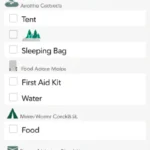Support our educational content for free when you purchase through links on our site. Learn more
10 Essential Items in a First Aid Kit [2024]

Did you know that having a well-stocked first aid kit can make a significant difference in emergency situations? Whether you’re out camping, hiking, or simply at home, having the right supplies on hand can help you provide immediate care and potentially save lives. In this article, we’ll explore the 10 essential items that should be in every first aid kit. So, let’s dive in and ensure you’re prepared for any situation!
Quick Answer
A well-equipped first aid kit should contain the following 10 essential items:
- Plasters in various sizes and shapes
- Sterile gauze dressings
- Eye dressings
- Triangular bandages
- Crêpe rolled bandages
- Safety pins
- Disposable sterile gloves
- Tweezers
- Scissors
- Alcohol-free cleansing wipes
Now, let’s take a closer look at each of these items and understand why they are crucial for your first aid kit.
Quick Tips and Facts
- A first aid kit should be easily accessible and stored in a cool, dry place.
- Regularly check your first aid kit for expired items and replace them promptly.
- It’s essential to familiarize yourself with the items in your first aid kit and how to use them properly.
- Consider taking a first aid training course to enhance your knowledge and skills.
Background: The Importance of a Well-Stocked First Aid Kit

Before we delve into the specific items, let’s understand why having a well-stocked first aid kit is so important. Accidents and emergencies can happen at any time, and having the necessary supplies readily available can make a significant difference in the outcome. A first aid kit allows you to provide immediate care and stabilize a person’s condition until professional medical help arrives. It can be a lifesaver in situations where time is of the essence.
1. Plasters in Various Sizes and Shapes
Plasters, also known as adhesive bandages, are a must-have in any first aid kit. They are designed to cover small cuts, grazes, and blisters, providing protection and promoting healing. Plasters come in various sizes and shapes to accommodate different wound sizes and body parts. Make sure your first aid kit includes a variety of plasters to cater to different needs.
✅ Quick Tip: Consider including waterproof plasters for added versatility, especially if you’re planning outdoor activities or water-related adventures.
2. Sterile Gauze Dressings
Sterile gauze dressings are essential for covering larger wounds or burns. They provide a clean and sterile environment for the wound to heal and help control bleeding. Make sure your first aid kit includes a range of sterile gauze dressings in different sizes to handle various injuries effectively.
✅ Quick Tip: Opt for individually wrapped sterile gauze dressings to maintain their cleanliness and sterility until use.
3. Eye Dressings
Eye injuries can be particularly delicate and require immediate attention. Including sterile eye dressings in your first aid kit is crucial for protecting and covering eye injuries until professional medical help is available. These dressings are designed to fit comfortably over the eye and provide a barrier against further damage.
✅ Quick Tip: Consider including eye wash and an eye bath in your first aid kit to flush out foreign objects or substances from the eye.
4. Triangular Bandages
Triangular bandages are versatile and have multiple uses in first aid situations. They can be used as slings to support injured arms, as a pad to control bleeding, or as a bandage to secure dressings in place. Their triangular shape allows for easy folding and adapting to different body parts.
✅ Quick Tip: Learn different techniques for using triangular bandages, such as creating an arm sling or immobilizing a fractured limb, to maximize their effectiveness.
5. Crêpe Rolled Bandages
Crêpe rolled bandages are elastic bandages that provide support and compression to injured limbs. They are commonly used to secure dressings, control bleeding, or provide support to sprained or strained joints. Including crêpe rolled bandages in your first aid kit ensures you have the necessary tools to stabilize injuries and prevent further damage.
✅ Quick Tip: Opt for bandages with clips or Velcro closures for easy application and adjustment.
6. Safety Pins
Safety pins are small but mighty tools that can come in handy in various first aid situations. They can be used to secure bandages, fasten slings, or even remove splinters. Including a few safety pins in your first aid kit ensures you have a versatile tool for improvising and adapting to different scenarios.
✅ Quick Tip: Consider attaching a few safety pins to the inside of your first aid kit’s lid for easy access.
7. Disposable Sterile Gloves
Disposable sterile gloves are essential for protecting both the first aider and the injured person from potential infections. They create a barrier between the skin and bodily fluids, reducing the risk of cross-contamination. Make sure your first aid kit includes an ample supply of disposable sterile gloves in various sizes.
✅ Quick Tip: Choose gloves made of latex-free material to accommodate individuals with latex allergies.
8. Tweezers
Tweezers are handy tools for removing splinters, thorns, or other foreign objects embedded in the skin. They allow for precise and controlled extraction, minimizing the risk of further injury or infection. Including a pair of tweezers in your first aid kit ensures you’re prepared to handle minor skin punctures effectively.
✅ Quick Tip: Look for tweezers with a pointed tip and a non-slip grip for optimal control and precision.
9. Scissors
Scissors are essential for cutting dressings, tapes, or clothing in emergency situations. They allow for quick and efficient access to wounds or injuries, ensuring proper care can be provided promptly. Make sure your first aid kit includes a pair of sharp, stainless steel scissors with rounded tips for safety.
✅ Quick Tip: Consider choosing scissors with a built-in safety mechanism that allows for safe storage within the first aid kit.
10. Alcohol-Free Cleansing Wipes
Alcohol-free cleansing wipes are gentle yet effective tools for cleaning wounds and preventing infection. They are particularly useful when access to clean water and soap is limited. Including a pack of alcohol-free cleansing wipes in your first aid kit ensures you can provide proper wound care even in challenging environments.
✅ Quick Tip: Look for cleansing wipes that are individually wrapped to maintain their moisture and sterility.
FAQ

What are 20 items in a first aid box?
A well-stocked first aid box may contain additional items to cater to specific needs or situations. Here are 10 more items you may consider including:
- Adhesive tape
- Sterile adhesive wound closure strips
- Burn dressings
- Instant cold packs
- CPR face shield
- Disposable resuscitation face mask
- Antiseptic solution or wipes
- Pain relief medication (e.g., paracetamol or ibuprofen)
- Antihistamine tablets
- Emergency blanket
Remember, the contents of a first aid box can vary based on individual needs and preferences. Customize your first aid kit to suit your specific requirements.
Read more about “What is First Aid Kit’s Most Famous Song? …”
What are 10 things every first aid kit should be equipped with?
In addition to the 10 essential items mentioned earlier, here are 10 more things every first aid kit should be equipped with:
- Adhesive tape
- Sterile adhesive wound closure strips
- Burn dressings
- Instant cold packs
- CPR face shield
- Disposable resuscitation face mask
- Antiseptic solution or wipes
- Pain relief medication (e.g., paracetamol or ibuprofen)
- Antihistamine tablets
- Emergency blanket
These additional items provide a more comprehensive range of supplies to handle various emergencies effectively.
What are 10 items in a first aid kit at home?
When it comes to a first aid kit at home, you may want to consider including the following 10 items:
- Plasters in various sizes and shapes
- Sterile gauze dressings
- Eye dressings
- Triangular bandages
- Crêpe rolled bandages
- Safety pins
- Disposable sterile gloves
- Tweezers
- Scissors
- Alcohol-free cleansing wipes
These items cover the basics and ensure you’re prepared to handle common injuries and emergencies that may occur at home.
What are 10 medicines in a first aid kit?
While a first aid kit primarily focuses on providing immediate care and wound management, including a few essential medicines can be beneficial. Here are 10 medicines you may consider including in your first aid kit:
- Paracetamol (pain relief and fever reducer)
- Ibuprofen (pain relief and anti-inflammatory)
- Antihistamine tablets (allergy relief)
- Antacids (indigestion relief)
- Oral rehydration salts (to combat dehydration)
- Anti-diarrheal medication
- Antiseptic cream (for minor cuts and burns)
- Hydrocortisone cream (for skin rashes and insect bites)
- Eye drops (for eye irritation or dryness)
- Saline nasal spray (for nasal congestion or allergies)
Including these medicines can provide additional relief and support in certain situations. However, always consult a healthcare professional for proper guidance and dosage instructions.
Conclusion

Having a well-stocked first aid kit is essential for any home, outdoor adventure, or travel. By including the 10 essential items we’ve discussed, you can be prepared to handle a wide range of injuries and emergencies. Remember to regularly check and replenish your first aid kit to ensure its contents are up to date and in good condition.
In summary, the 10 essential items in a first aid kit are:
- Plasters in various sizes and shapes
- Sterile gauze dressings
- Eye dressings
- Triangular bandages
- Crêpe rolled bandages
- Safety pins
- Disposable sterile gloves
- Tweezers
- Scissors
- Alcohol-free cleansing wipes
With these items at your disposal, you’ll be well-equipped to provide immediate care and potentially save lives in emergency situations.
Recommended Links
- Camping Preparation Guide
- Camping Food and Nutrition
- Camping Gear Basics
- Camping Gear Reviews
- Camping Essentials
- First Aid Kit – Who is the Lead Singer of the First Aid Kit?
Reference Links
- What should I keep in my first aid kit? – NHS
- American Red Cross – First Aid Kits
- Mayo Clinic – First Aid Kits: Stock Supplies That Can Save Lives
Remember, accidents can happen when you least expect them. By being prepared and having a well-stocked first aid kit, you can be the difference between a minor incident and a major emergency. Stay safe and take care!

